Changing a Flat Tire
NOTE:
If the following occurs while driving, it could
indicate a flat tire.
- Steering becomes difficult.
- The vehicle begins to vibrate excessively.
- The vehicle pulls in one direction.
If you have a flat tire, drive slowly to a level spot that is well off the road and out of the way of traffic to change the tire.
Stopping in traffic or on the shoulder of a busy road is dangerous.
WARNING:
Be sure to follow the directions for
changing a tire, and never get under a
vehicle that is supported only by a jack:
Changing a tire is dangerous if not
done properly. The vehicle can slip off
the jack and seriously injure
someone. If getting under the vehicle
becomes necessary use vehicle
support stands.
Never allow anyone inside a vehicle
supported by a jack:
Allowing someone to remain in a
vehicle supported by a jack is
dangerous. The occupant could cause
the vehicle to fall resulting in serious
injury.
NOTE:
Make sure the jack is well lubricated before
using it.
1. Park on a level surface off the right-ofway and firmly set the parking brake.
2. Put a vehicle with an automatic transaxle in Park (P), a manual transaxle in Reverse (R) or 1, and turn off the engine.
3. Turn on the hazard warning flasher.
4. Have everyone get out of the vehicle and away from the vehicle and traffic.
5. Remove the jack, tool, and spare tire.
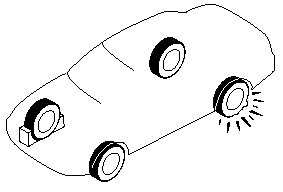
6. Block the wheel diagonally opposite the flat tire. When blocking a wheel, place a tire block both in front and behind the tire.
NOTE:
When blocking a tire, use rocks or wood blocks
of sufficient size if possible to hold the tire in
place.
Removing a Flat Tire
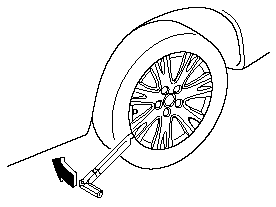
1. If your vehicle is equipped with a wheel cover, pry off the wheel cover with the beveled end of the lug wrench.
NOTE:
Force the end of the lug wrench firmly between
wheel and cover, or removal will be difficult.
CAUTION:
Align the notch on the wheel cover
with the valve stem when installing
it.
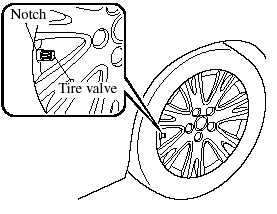
Damage could occur during installation if the wheel cover is not properly aligned.
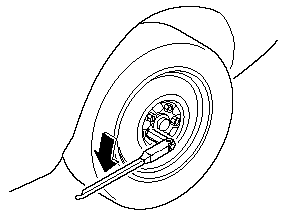
2. Loosen the lug nuts by turning them counterclockwise one turn each, but don't remove any lug nuts until the tire has been raised off the ground.
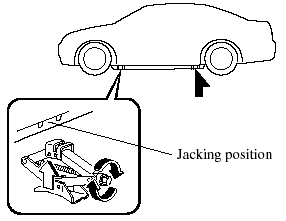
3. Place the jack under the jacking position closest to the tire being changed.
WARNING:
Use only the front and rear jacking
positions recommended in this manual:
Attempting to jack the vehicle in
positions other than those
recommended in this manual is
dangerous. The vehicle could slip off
the jack and seriously injure or even
kill someone. Use only the front and
rear jacking positions recommended
in this manual.
Use only the jack provided with your
Mazda:
Using a jack that is not designed for
your Mazda is dangerous. The vehicle
could slip off the jack and seriously
injure someone.
Never place objects under the jack: Jacking the vehicle with an object under the jack is dangerous. The jack could slip and someone could be seriously injured by the jack or the falling vehicle.
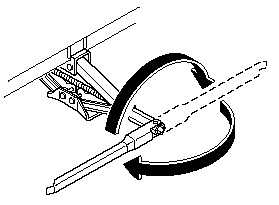
4. Turn the lug wrench clockwise and raise the vehicle high enough so that the spare tire can be installed. Before removing the lug nuts, make sure your Mazda is firmly in position and that it cannot slip or move.
5. Remove the lug nuts by turning them counterclockwise; then remove the wheel and center cap.
Locking Lug Nuts
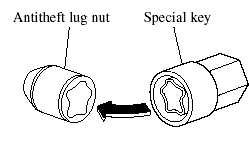
If your vehicle has optional antitheft wheel lug nuts, one on each wheel will lock the tires and you must use a special key to unlock them. This key is attached to the lug wrench and is stored with the spare tire. Register them with the lock manufacturer by filling out the card provided in the glove box and mailing it in the accompanying envelope. If you lose this key, consult an Authorized Mazda Dealer or use the lock manufacturer's order form, which is with the registration card.
To remove an antitheft lug nut
1. Obtain the key for the antitheft lug nut.
2. Place the key on top of the nut, and be sure to hold the key square to it. If you hold the key at an angle, you may damage both key and nut. Don't use a power impact wrench.
3. Place the lug wrench on top of the key and apply pressure. Turn the wrench counterclockwise.
To install the nut
1. Place the key on top of the nut, and be sure to hold the key square to it. If you hold the key at an angle, you may damage both key and nut. Don't use a power impact wrench.
2. Place the lug wrench on top of the key, apply pressure, and turn it clockwise.
Mounting the Spare Tire
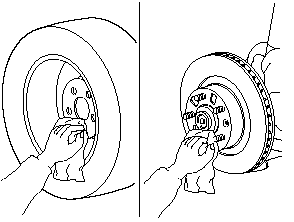
1. Remove dirt and grime from the mounting surfaces of the wheel and hub, including the hub bolts, with a cloth.
WARNING:
Make sure the mounting surfaces of
the wheel, hub and lug nuts are clean
before changing or replacing tires:
When changing or replacing a tire,
not removing dirt and grime from the
mounting surfaces of the wheel, hub
and hub bolts is dangerous. The lug
nuts could loosen while driving and
cause the tire to come off, resulting in
an accident.
2. Mount the spare tire.
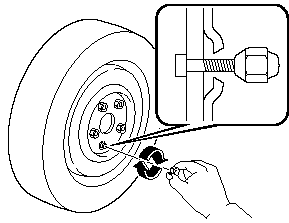
3. Install the lug nuts with the beveled edge inward; tighten them by hand.
WARNING:
Do not apply oil or grease to lug nuts
and bolts and do not tighten the lug
nuts beyond the recommended
tightening torque:
Applying oil or grease to lug nuts and
bolts is dangerous. The lug nuts
could loosen while driving and cause
the tire to come off, resulting in an
accident. In addition, lug nuts and
bolts could be damaged if tightened
more than necessary.
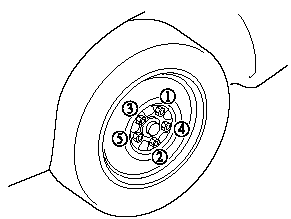
4. Turn the lug wrench counterclockwise and lower the vehicle. Use the lug wrench to tighten the nuts in the order shown.
If you're unsure of how tight the nuts should be, have them inspected at an Authorized Mazda Dealer.

WARNING:
Always securely and correctly tighten
the lug nuts:
Improperly or loosely tightened lug
nuts are dangerous. The wheel could
wobble or come off. This could result
in loss of vehicle control and cause a
serious accident.
Be sure to reinstall the same nuts you removed or replace them with metric nuts of the same configuration: Because the wheel studs and lug nuts on your Mazda have metric threads, using a non-metric nut is dangerous.
On a metric stud, it would not secure the wheel and would damage the stud, which could cause the wheel to slip off and cause an accident.
5. Remove the center cap by tapping it with the lug wrench.
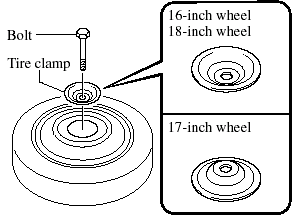
6. Store the damaged tire, using the tire hold-down bolt to hold it in place.

7. Store the damaged tire in the trunk.
8. Check the inflation pressure. Refer to the specification charts.
9. Have the flat tire repaired or replaced as soon as possible.
WARNING:
Do not drive with any tires that have
incorrect air pressure:
Driving on tires with incorrect air
pressure is dangerous. Tires with
incorrect pressure could affect
handling and result in an accident.
When you check the regular tires' air pressure, check the spare tire, too.
NOTE:
To prevent the jack and tool from rattling, store
them properly.
See also:
Happy-Face Looks
The biggest styling difference between the 2010 and 2009 CX-7 is that the
2010 adopts a version of Mazda's grinning grille, which has already shown its
face on the redesigned Mazda3 compact car, a ...
Antenna
Detachable Type
To remove the antenna, turn it
counterclockwise.
To install the antenna, turn it clockwise.
Make sure the antenna is securely
installed.
Type A
Type B
CAUTION:
To prevent ...
Antenna
Detachable Type
To remove the antenna, turn it
counterclockwise.
To install the antenna, turn it clockwise.
Make sure the antenna is securely
installed.
CAUTION.
To prevent damage to the
an ...


